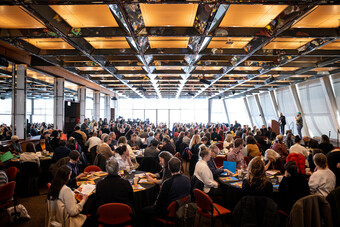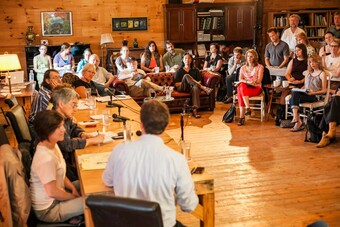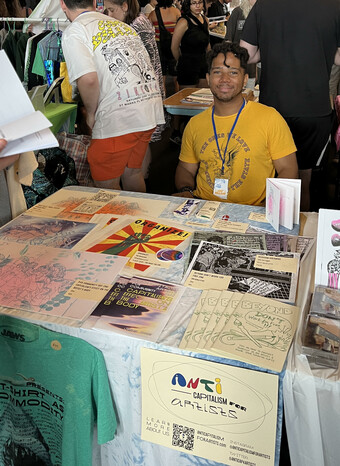Stuck in Stupid
Change is hard for many people, most often because we fear the unknown. What will happen if I change? Suppose things don’t get better? It’s easy to get stuck doing the same behavior over and over, even when that behavior ignores the inevitable change that is taking place all around us. Stuck in stupid.
Theatres, like people, can be resistant to change. They need to respond to cultural shifts, changes in behavior, and consumer tastes, yet many theatres are stuck in stupid. Responding to consumer demand does not mean abandoning one’s mission or values. It simply means reimagining your operation to stay relevant.
Historically, theatres have evolved to remain relevant. From socially and politically conscious theatre of the 1930s to the 1950s, to the “Little Theatre Movement” that gave rise to black box theatre and a new generation of playwrights, theatres have reimagined what they do to keep pace with their audiences.
I believe that theatre is on the cusp of another landmark change that will require us, as artists and managers, to reinvent ourselves. I get frustrated when I talk to theatre managers who are clinging to the existing model, unable or unwilling to see the changes that are taking place before them.
Some of today’s, and all of tomorrow’s, audiences have been raised in a digital era, a place where information is immediately accessible and entertainment can be adapted to the user’s preferences. We communicate at a faster pace—not necessarily better—but faster. And, we engage with one another in vastly different ways.
Why are we so blind to see how this will affect theatre?
Faced with abundant choices, today’s (and more importantly, tomorrow’s) theatre audiences want more and demand more. The theatre we produce today is at risk of becoming irrelevant unless we respond to those demands and get unstuck.
I believe that theatre is on the cusp of another landmark change that will require us, as artists and managers, to reinvent ourselves. I get frustrated when I talk to theatre managers who are clinging to the existing model, unable or unwilling to see the changes that are taking place before them.

Eleven tips for getting your theatre unstuck:
- What’s Your Strategy?
It is critical to define a strategy that is yours and yours alone. I see many theatres that build a strategy based on other theatres—sometimes competitors, often theatres they simply admire. Your theatre is unique, or at least I hope it is. You need to define your “marketing differentiator.” What is it that sets your theatre apart from all the others in your marketplace? This is the foundation of your strategy.Then define where you want to go. What do you want your theatre to be? To be known for? Who will be your audience (and be specific: gender, race, level of education, occupation, income, are they gay or straight, how do they dress)?
When I consult for theatres, I often lead them through a visioning exercise where I ask, “If you were starting this theatre today, from scratch, what would it look like?” That’s a revealing question; it allows you to dream about your perfect theatre without being restricted by the confines of your current operation. Ask your team this question and then go build it.
- Put the Business in Show Business.
I know, business and art are never supposed to mix, but I beg you to change that way of thinking. Business: please meet Art. Art: please meet Business. I think you two will get along just fine. Now, let’s talk.Why do you think your theatre isn’t a business? Because you’re mission-driven? Pshaw! You employ people, you pay payroll taxes, offer healthcare benefits, have to deal with things like insurance, unions, and liability. You are a business! Start acting like one.
Adhering to good business practices doesn’t mean you have to abandon your mission and values. It just ensures you will be around long enough to fulfill them.
- Tear Down Those Walls Mr. Producer!
Stop working under old, rigid models of structure, particularly when it comes to staff. As artists, we love creative new works, so why do we fear creativity off stage?Decide who and what your theatre needs and then make it happen. Do you really need a director of marketing and a director development? Or, would your theatre benefit from one director of community engagement and use the cost-savings to hire more staff beneath him/her to handle the specific tasks?
-
We live in a world of digital communication and social media. Our interactions are generally less formal, more spontaneous, and sometimes more clever. Does your theatre need a Facilitator of Fun, a Director of Creativity, or a Next Gen Manager? Think about what your theatre needs and do away with the organizational structures you’ve inherited. You will discover a more vibrant, reenergized workforce that will lead you to new audiences and new donors.
- Play to Your Occupied Seats; Program to Your Empty Seats.
Your current audience will be dead or have moved on in five years (or maybe five days…have you seen that old guy in the third row?). Why do you keep programming to them?I’m not advocating that you abandon your current audience completely; that would be silly, especially since many of them are donors. But, stop asking “what do they think?” and “what shows do they want to see?” You already know the answers to those questions—their butts are in your seats now.
Go on a Butt Hunt. Put together informal groups of constituents (people who don’t currently come to your theatre) and talk with them. Program to your empty seats. Ask them what are the barriers to coming (I guarantee you, ticket prices will only be one of them), and how best to communicate with them.
Assemble focus groups of potential audience members (people from the above group, single ticket buyers, first-timers) and ask them about programming. Don’t be lazy and ask them for show titles; they probably won’t know titles offhand. Instead, ask them for themes that appeal to them: comedy, drama, farce, satire, political, LGBTQ, historical, etc. Once you know the types of plays they want to see, you can go find relevant titles. And, knowing these themes will tell you exactly how to market these plays.
- Embrace Technology Onstage.
Find ways of incorporating new technologies such as video and projection into your productions. Younger audiences expect this type of dynamic experience and you should use every tool in your arsenal to appeal to them.This does not mean you should turn your theatre into a theme park, but you can take a few lessons from them. Shows already use smoke and fog machines, rain, water, sound effects, and they make characters fly above the audience. Why not use technologies that arouse the other senses, like smell, to achieve a similar effect?
Most people are attached to their smart phones. A recent study showed that more than 30 percent of people sleep with their phones and one in three would give up sex before their phone. Why do we insist that audiences turn off their phones and put them away? Instead, let’s find ways to responsibly incorporate cell phone behavior into our shows (and I don’t mean taking/receiving phone calls).
I did a production of The Tempest where we instructed the audience to take flash photos of the bare stage at the beginning of the show to simulate lightning. We told them to share their pics on Facebook and Twitter while tagging our event. It was at the beginning of the show and it was not intrusive, but it engaged the audience in a way that made them feel more connected to the show, through their technology. And, it was great publicity online!
- Embrace Technology Offstage.
I’m just going to say it, it’s time to overhaul our old marketing models and incorporate digital marketing as a core element, not an add-on. In fact, except in certain unique markets, marketing should be rebuilt with digital media as the core and print as the accessory.Statistically, you know what type of audience responds to print marketing. Are they filling your houses? Will they continue to do so for the next twenty-plus years? Unless you can answer “yes” to both these questions, you need to alter your marketing in a serious way.
I see many theatres that leave social media marketing to short-term interns or assistants. Why is this type of marketing considered less important than any other? Successful theatres need to begin hiring experienced professionals to manage their digital presence. Pay for this position through a reduction in print advertising. Trust me, it will pay off.
Develop a strategy for your online marketing and follow it. Don’t just post a fun picture or special offer to Facebook when you have time. That’s not strategy, that’s spontaneity. Just as you develop a print schedule, do the same for online marketing—including social media.
Encourage your audience to talk about you on Facebook and Twitter. People trust the judgment of their friends and if one person likes a show their friends will likely go see it.
- Use Demographics and Psychographics.
I know, I know, science and art, that old right brain/left brain thing. Getting through your daily life— from dressing in the morning to cooking dinner at night—requires using both your left and right brains. If you can do it for socks and spaghetti, surely you can do it for the theatre.Take time to study your existing audience. Build an accurate demographic profile so you know who you are dealing with. Then, overlay this with a psychographic profile (how people engage with your organization) of this same group.
Now, do the same thing for your community as a whole—your potential audience. Knowing who you are talking to is the first step in knowing how to talk to them.
Your theatre engages different demographic groups, from Seniors and Baby Boomers to Gen X and Gen Y/Millennials. Each one of these groups prefers to be communicated with in a slightly different way. You wouldn’t text a senior, so why would you mail a letter to a millennial and expect him/her to respond?
Combined, demographics and psychographics are a powerful tool for both marketing and development. For example, if you have a baby boomer (demographics) who likes regular contact with your theatre (psychographics), don’t be afraid to send them regular email communication—an article you think might interest them, letters from a school trip, or photos from a strike/load-in.
It doesn’t take sophisticated or expensive technology to collect this information. The equipment you already have is probably sufficient. It just takes time (and I know that’s a precious resource). But, if you don’t have time now to find ways of reaching a new audience, I guarantee you will have plenty of time five years from now when that audience goes elsewhere.
- Think Outside the Black Box.
To get people into your theatre, maybe you have to first take the theatre to them. Black box theatres have always been home to new and innovative work. But now, theatre is moving outside and into unique venues. Think about how you can do this with your theatre.Create a version of “Urban Street Theatre” by presenting plays in various locations in your town. Have the audience gather at your theatre and then lead them on a walking tour/performance in your neighborhood, stopping along the way at various businesses and locations where different scenes are performed. Readapt classic works from Shakespeare or commission new works that celebrate the history of your town.
Find alternative places to stage performances—parks, schools, abandoned factories, hotels. If our goal is to make theatre more accessible to new audiences, maybe the environment has to be equally as accessible.
- Rethink Physical Spaces.
Can your box office be transformed into a coffee shop? Can your lobby be opened up for jazz performances before or after the show? Do you have room to open a small used bookshop or a free library of theatre books and scripts? Will some be stolen? Sure, but who cares? Your volunteers and donors will have more they will contribute.Make your theatre building a destination for things besides seeing a play. If you make your community feel comfortable in your space, make them feel welcome, they are more likely to come back to see a show. Plus, the in-house marketing opportunities (posters and big screen TVs) are a great way to interest patrons who might just be dropping by for a cup of coffee or to borrow a book.
- Examine Pricing Structures.
You knew I was going to mention this, didn’t you? Well, then you already know that you have to look for ways to make your theatre more affordable. We need to break this mistaken belief that theatre is elitist and only for well dressed white folks.Avoid gimmicks, coupons, and special offers. You only condition people to wait for the discount instead of buying when they first see the offer. Plus, I think these types of “specials” devalue the artistic product.
Decide upon a price your theatre can live with and apply it equally. Avoid confusion by eliminating many pricing variables (previews, matinees, weeknights, etc). The point is to get butts in seats.
Except in those areas where senior populations are growing, you need to begin thinking of programs to replace subscriptions. Newer audiences can’t plan that far in advance. Young parents have children’s schedules to juggle and work pressures, while even younger audiences simply prefer to be more spontaneous. Don’t make them adapt to your model (they won’t); find ways to adapt to their needs.
In addition to an inability to plan far in advance, younger people simply can’t expend the money necessary to buy subscriptions. Models like Portland Stage Company’s ScenePass allow those under thirty-five to sign up for a $10 per month pass (charged directly to their credit card) and get free admission to any performance. Be creative in your approach.
- The Beyoncé Rule: Listen.
The most important thing we all can do is to listen to each other. Once a month, gather your staff in a big room, throw a bunch of colorful sticky notes and markers on the table, and ask your staff to write down one thing they think you can (or should) do to make your theatre better. Give them five minutes and then stick the notes to the wall, read them aloud, and then walk away. Don’t debate the merit of the ideas, just listen and absorb.We, as human beings who often hate change, like to find reasons why something won’t work. Don’t allow that to happen. You never know where your next bright idea will come from. Just listen to the ideas, let the sticky notes stay on the wall until the next meeting when you can then take time to discuss the merits of each one.
And, most importantly, don’t discriminate where those ideas come from. Your technical director may have a great marketing idea and your development director may have a brilliant idea for the box office. Listen.
Listen closely to your interns, if you’re lucky enough to have them. Each season the theatre gods bring you a handful of young, eager, theatre lovers who are bursting with new ideas. Listen. Embrace them. They speak for a new audience and represent a different perspective. And, it’s a valid one.
This is an exciting time in which to create theatre. We are being given the opportunity to reinvent our art and embrace a new generation of theatregoers. That audience is out there —desperate for live theatre—if we can find ways to be relevant to them.
Grind those gears, rev your engines, and get your theatre unstuck from stupid.









Comments
The article is just the start of the conversation—we want to know what you think about this subject, too! HowlRound is a space for knowledge-sharing, and we welcome spirited, thoughtful, and on-topic dialogue. Find our full comments policy here
Excellent!
Norman. that is the artistic mission. Learn to communicate with your audience
Great reinvigorating presentation. Now how does the artistic mission fit in?